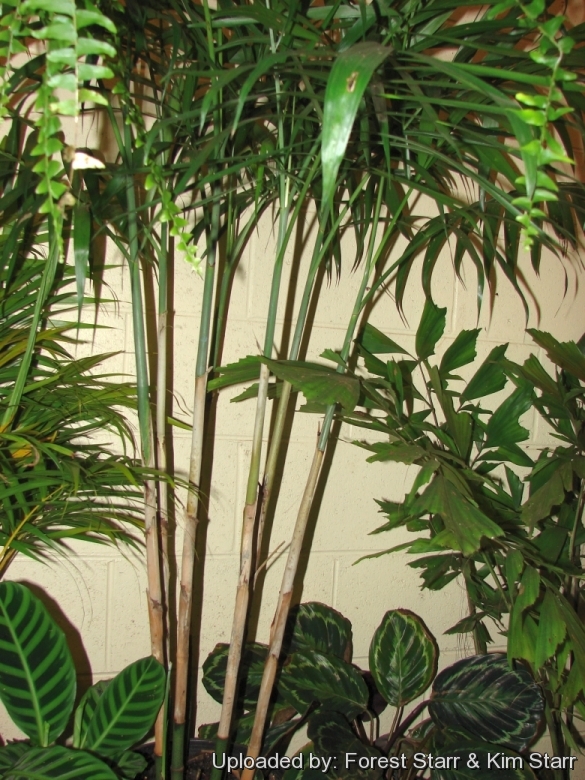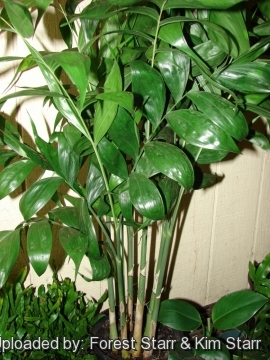
Chamaedorea seifrizii Photo by: Forest Starr & Kim Starr
Origin and Habitat: Mexico and Central America.
Habitat: It thrives as an understory palm in moist or seasonally dry highland rainforests.
Ecology: Fruits are dispersed by birds.
Synonyms:
See all synonyms of Chamaedorea seifrizii
back
Accepted name in llifle Database:Chamaedorea seifrizii BurretNotizbl. Bot. Gart. Berlin-Dahlem 14: 268 1938Synonymy: 4
back
Common Names include:
ENGLISH: Seifriz's bamboo palm, Reed palm, Bamboo palm, Cane Palm, Clustered Parlor Palm, Bamboo Palm Tree
MALAY (بهاس ملاي /Bahasa Melayu ): Palma buluh
PORTUGUESE (Português): Camedórea-bambu (Brazil)
Description: Chamaedorea seifriziiSN|24303]]SN|24303]] is a very common, inexpensive, pretty versatile palm, very often available from garden centres. It is a dense, moderately fast growing species that grows to about 1,5-3 m tall and clumps profusely forming large bounces with hundreds individual plants. Spread 0,7-1,5 m . It naturally spreads by suckers or offshoots also similar to Bamboo.
Stem: Long and slender with nodes and knobbly protuberances very similar in appearance to Bamboo. The individual stems are tall and have about 10-15 fronds. Since lower leaves drop from the plant as it grows, older palms have all their foliage on top of the stem. At the base of the stem, just above the soil surface small adventitious roots can often be seen.
Leaves (fronds): Short deep green up to 45 cm long and contain up to 14 shiny, leaflets on each side of the frond. The segments may be narrow or broad, terminal segments may be equal or wider than other segments, and segments may be upright or flat.
Flowers: The inflorescences arise from the leaf sheaths or covering below the palm fronds, the flowers are dull yellow in colour. Separate plants produce pollen (staminate) and ovule (pistillate).
Fruits: Small pea-sized, ripening from orange/red to almost black and only about 1 cm in diameter.
Bibliography: Major references
1) Forest & Kim Starr Chamaedorea seifrizii (bamboo palm). Plants of Hawaii. <http://www.starrenvironmental.com>. Downloaded on 21 August 2014.
2) Don Ellison, Anthony Ellison “Cultivated Palms Of The World” UNSW Press, 01/mag/2001
3) Robert Lee Riffle, Paul Craft “An Encyclopedia of Cultivated Palms” Timber Press, Portland 2007
4) John Dransfield, Natalie W. Uhl, Conny B. Asmussen, William J. Baker, Madeline M. Harley, Carl E. Lewis: “Genera Palmarum. The Evolution and Classification of Palms.” Royal Botanic Gardens, Kew 2008
5) David Jones: “Palmen” Könemann, Köln, 2000
6) Breedlove, D. E. 1986. "Flora de Chiapas" Listados Floríst. México 4: i–v, 1–246.
7) CONABIO. 2009. "Catálogo taxonómico de especies de México." 1. In Ca. nat. México. CONABIO, Mexico City.
8) Henderson, A., G. Galeano & R. Bernal. 1995. "Field Guide Palms Americas" 1–352. Princeton University Press, Princeton, New Jersey.
9) Hodel, D. R. 1992. "Chamaedorea Palms" 1–338. The International Palm Society, Lawrence.
10) Pérez, A., M. Sousa Sánchez, A. M. Hanan-Alipi, F. Chiang Cabrera & P. Tenorio L. 2005. "Vegetación terrestre." 65–110. In Biodiver. Tabasco. CONABIO-UNAM, Mexico.
 Chamaedorea seifrizii Photo by: Forest Starr & Kim Starr
Chamaedorea seifrizii Photo by: Forest Starr & Kim StarrSend a photo of this plant.The gallery now contains thousands of pictures, however it is possible to do even more. We are, of course, seeking photos of species not yet shown in the gallery but not only that, we are also looking for better pictures than those already present.
Read More... Cultivation and Propagation: It is cultivated in tropical and subtropical regions and planted in gardens and parks. It is widely cultivated in temperate regions as a house plant. If you needs a small low maintenance, but graceful looking palm, it doesn't get any better than Chamaedorea seifriziiSN|24303]]SN|24303]] or The Bamboo Palm. Its usually seen in clumps and tolerating crowded roots and low light levels.
Soil: It likes likes a humus-rich, slightly acidic soil.
Fertilization: Need a perfect fertilizer diet including all micro nutrients and trace elements or slow release fertilizer applied every one or two months, or according to package directions, using a fertilizer specifically formulated for palms.
Water Requirements: It tolerates low levels of humidity for short periods, though it prefers evenly moist but not consistently wet medium. During the winter months, water is somewhat restricted and fertilizer is withheld until new growth starts in the spring. Outdoors this palm prefers its feet in good, enriched soil, its head in the sun, and regular irrigation.
Light: It can grow in semi-shade (light woodland) or in full sun and requires a bright spot for indoor cultivation, though may tolerate low levels light. It produces flowers and fruit only in sunny positions.
Wind resistance: It does best protected from drying winds.
Hardiness: These palms are hardy in the landscape in USDA zones 9a -12.
Roots: Usually not a problem
Maintenance: For the healthiest and most attractive plant, keep the palm pruned. As the old fronds die, these should be trimmed off and the leaf bases or sheath allowed to dry out. Later these should be removed as this promotes good plant hygiene and exposes the attractive light green "bamboo stem", but do not prune if the frond still has some green colour. Palms recycle nutrients from dead or dying fronds and use them for healthier fronds.
Pest and diseases: A common pest to this plant is the spider mite which might happen indoors in a dry area. If you notice spider mites, try mist the plant twice a day with a soapy water mixture. If this does not work, go to your local plant or hardware store and try a professional grade pest remover. Much less common is scale, mealy bug or but rot. Gliocladium blight and Phytopthora can also affect this palm but they far less commonly seen.
Uses: Specimen palm in offices, malls or homes. In warm climates it may be used in protected areas outside as a screen, hedge or accent to the landscape.
Propagation: By division of suckers or offshoots which allows the production of a large number of individuals more quickly than if seed germination is required or by seed which takes 6 months or more to germinate.
Warning: The fruit is very toxic and should not be eaten it is also an irritant to humans skin and eyes.










